-
Shapes of a human face in profile can be presented as combinations of geometrical figures, and accordingly the sizes and proportions of a human face can be considered as proportional ratio of geometrical figures, that is shown on the chart.
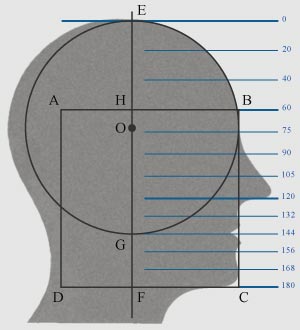 |
The basic figures of physiognomy are the square and the circle. Sides of the square have sizes which are equal to the distance between chin and eyebrows, namely the square ABCD is an equilateral rectangular in which the side CD corresponds with border of a chin and the side AB corresponds with border of eyebrows, and the side BC determines the square size. Borders of physiognomic spheres and facial levels on the chart are shown by blue lines which designate the scale of measurements of human faces in physiognomy. The side BC is a tangent line to the maximal expressed point of a chin and to the maximal expressed point of eyebrows, and angles of the square have 90 degrees. The square corresponds with physiognomic spheres of individuality and feelings. If sizes of physiognomic spheres are correct then the square's side has 120 zens. But it is necessary to take into account that faces of people have individual physiognomic proportions and consequently sizes of squares can be different. |
The circle has the size from top of a head up to a mouth (border between
upper and lower lips), namely diameter of the circle with the centre in point O
is a distance between points E and G, provided that the point E corresponds
with the line on top of a head and the point G corresponds with the line of a mouth.
To calculate diameter of the circle, it is necessary to draw the line on top of
a head parallel to the side AB of square, and this line should be a tangent to
the maximal high point of a head. After that it is necessary to draw a circle
which is tangent to the side BC in the square and is tangent to the line of top of a
head and tangent to border of a mouth. Then it is necessary across the centre
of the circle to draw the perpendicular line to the side AB of square, and in a
result crossing of this line with the circle will specify points E and G.
In some cases maximum high point of a head can not coincide with point E, but
in any case the circle should be a tangent to the line of top of a head, namely
it is necessary to commensurate shapes of a human face with above mentioned
physiognomic drawings and measurements correctly as they allow correctly to find the
centre of the circle in point O and allow to find the diameter EG.
The circle corresponds with physiognomic spheres of consciousness and
individuality, and also in part corresponds with the sphere of feelings. If sizes of physiognomic spheres
are correct then diameter of the
circle has144 zens, but if sizes differ from correct then diameter of the circle
can be other. And also
position of the point O (centre of the circle) can be various depending on
individual proportions of a half face of this or that man.
Geometrical ratio of the circle and the square determine proportions of a
human face from the point of view of physiognomy. Namely at the correct sizes of
physiognomic spheres the attitude of distance EF to distance OF has value
180/108=1,666... (or at division of the smaller size by big 108/180=0,6), that
approximately corresponds to value of the gold section.
That proportional ratio of the circle and the square would be most equal to value of the gold section, distance OF should have
the size
approximately 111,222... zens. Then attitude EF/OF matters 180/111,222...=1,618
that is equal to the gold section (at division of the smaller size by big 111,222
.../180=0,6179). Such proportional ratio which corresponds to the gold section
are in faces of ancient Greek sculptures where a mouth does not correspond with
correct proportions of physiognomic spheres.
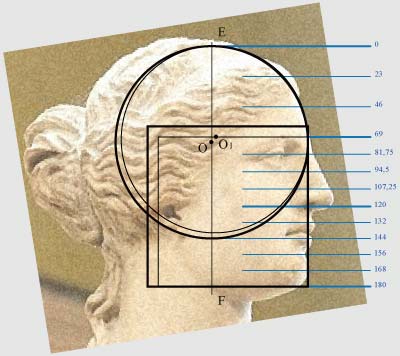 |
As it is possible to see on the chart, the sculptural profile of
Venus has wrong position of a mouth from view of correct
proportions, namely the distance from top of a head up to border of a
mouth (border between upper and lower lips) is less rather than
144 zens though as a whole the physiognomic sphere of feelings from a
nose up to a chin has correct proportions.
In this connection the circle has smaller diameter in distance from top of a head up to border of a
mouth. To proportions of the shown sculptural profile of Venus there corresponds the circle shown by a thin line, and a fat line shows the circle appropriate to correct proportions of physiognomic spheres. The centre of the correct circle is in point O, and the centre of the changed circle is in point O1. Attitude EF/OF is 1,666 but attitude EF/O1F is 1,618 that corresponds to the gold section which is typical in the canon of ancient Greek sculptures. |
Besides in the shown sculptural profile of Venus the physiognomic sphere of
consciousness is increased in comparison with the sphere of
individuality, and as a result the square (shown by thin lines) has the smaller size in comparison with the
correct square (shown by fat lines). The smaller size is the reason of that the
center of the circle in point O1 coincides with the side
of the square, that is one more sculptural feature of the shown facial profile
of the Greek goddess Venus.
Also in half faces of ancient Greek sculptures and in the shown facial profile of Venus it
is possible to see many other remarkable geometrical proportions which are changed in
comparison with correct canon, but are coordinated with proportions of the gold
section.
Completely correct geometrical proportions of physiognomic spheres can be seen in the
facial profile of Napoleon.
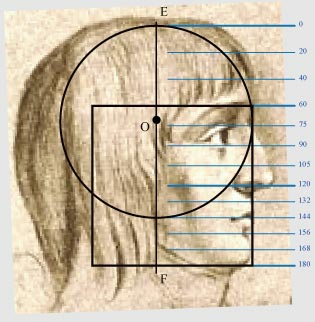 |
The shown image is the drawn (portrait) profile of
Napoleon in the age of 17 years. It is possible to assume that the artist has purposely calculated correct proportions of the drawn face, but also it is possible to assume that actually the half face of emperor Napoleon had perfect proportions in view of physiognomy. As in the shown portrait it is possible to see that each physiognomic sphere has the size of 60 zens. The attitude of distances EF to OF is 1,666... Diameter of the circle is equal to the distance from top of a head up to the line of a mouth that has the size 144 zens (the line of a mouth within the physiognomic scale of measurements coincides with border of a mouth). The line of top of a head is designated approximately as it is necessary to take into account hair which visually hide the valid top. |
-
In faces of people proportional ratios of physiognomic spheres can be different but in each human face there are especial geometrical laws and proportions. For example, the half face of Britney Spears on photo which from the point of view of physiognomy is remarkable that there are no hair, and as a result on the photo it is possible to see exact top of a head.
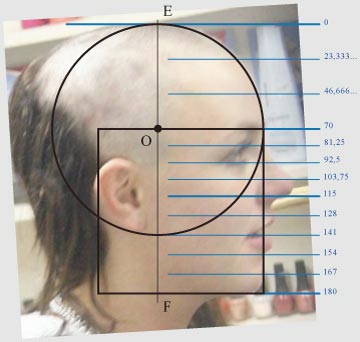 |
In the facial profile of Britney Spears on photo the physiognomic sphere of consciousness has the size of 70 zens, the sphere of individuality has 45 zens, the sphere of feelings has 65 zens. It is a wrong proportional ratio of physiognomic spheres, but as a whole the attitude of distances EF to OF is 180/110=1,636 (at division of the smaller size by big 110/180=0,611) that approximately corresponds to value of the gold section, and also the centre of the circle in point O coincides with the side of square that is similar to the facial profile of Venus. Diameter of the circle has the size of 141 zens but the line of a mouth is correct within the framework of physiognomic sphere of feelings, as the distance from top of a head up to border of a mouth is equal to diameter of the circle. |
As a whole the half face of Britney Spears is balanced harmoniously though
proportional ratio of physiognomic spheres differ from correct proportions.
In the shown photo the mouth is slightly opened, and consequently can seem that
the increase of physiognomic sphere of feelings is caused by movement of the
lower jaw, but also the mouth can be slightly opened as a result of slackness of
the lower lip. Namely the mouth can be opened as a result of movement of the
lower jaw that changes visible sizes of a face, or the mouth can be opened as a
result of an emotional relaxation of the lower lip that does not change facial
sizes.
The following image is the face of real woman but the photo is edited in the
graphic computer program.
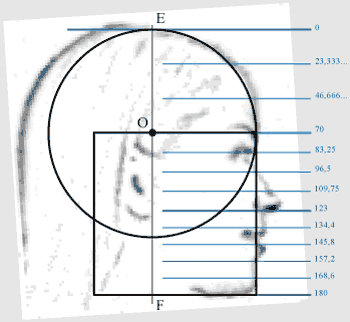 |
The physiognomic sphere of consciousness has the size
of 70 zens, the sphere of individuality has 53 zens, the sphere of
feelings has 57 zens. It is a wrong
proportional ratio of physiognomic spheres, but as a whole the attitude
of distance EF to distance OF is 180/110=1,636 (the similar
ratio can be seen in the facial profile of Britney Spears) that
approximately corresponds to
value of the gold section, and also the centre of the circle in point O
coincides with the side of square. The border of a mouth is wrong and
consequently diameter of the circle has the size of 141 zens, and the
correct line of a mouth should be located on a distance of 145,8 zens
from top of a head according to the scale of measurements of
physiognomy. Not looking at wrong border of a mouth and wrong proportions of physiognomic spheres nevertheless the ratio of the square with the circle is proportional, as the centre of the circle in point O coincides with the side of square. Wrong position of a mouth and concurrence of the centre of circle to the side of square also can be seen in the sculptural profile of Venus above. |
The shown geometrical measurements allow to determine sizes of physiognomic
spheres in a context of physiognomy.
If a size of this or that physiognomic sphere is more than correct value (more than
60 zens) then this sphere prevails, and if the size is less than 60 zens then the
sphere is insufficient, that allows to draw psychological conclusions on features
of human character.
If the sphere of consciousness prevails then the man or woman is sure in own thinking,
and if the sphere of consciousness is insufficient then thinking is
uncertain.
If the sphere of individuality prevails then the man or woman is sure in own personality
(self-confident), and if the sphere of individuality is insufficient
then the person is not sure in own personal features.
If the sphere of feelings prevails then the man or woman is sure in own
sensuality, and if
the sphere of feelings is insufficient then the person doubts of sensual
displays.
It is necessary to mean that physiognomic spheres of a human face are
prevailing or insufficient concerning the vertical scale of measurements that is
not connected to the horizontal measure scale concerning which
physiognomic spheres can be expressed or not expressed. Namely the offered
facial scale is vertical, and the information on the horizontal scale of
measurements in physiognomy look in other sections of this web site.
Except for vertical sizes of physiognomic spheres, and except for proportional
features of human faces by means of geometrical ratios of the circle with square
it is possible to see ratios of consciousness with feelings. The circle is
possible to name by the term "circle of consciousness" and the square is
possible to name "square of feelings", and accordingly by means of physiognomic
analyses of geometrical ratios it is possible to do psychological conclusions.
Namely attitudes of distances OF to EF and also HF to EF it is possible to
consider as numerological numbers which allow to characterize psychological
features of people.
OF/EF specifies the proportional ratio of height of a head with circle of
consciousness and consequently numerical value of this ratio means psychological
features of the thinking.
HF/EF specifies the proportional ratio of height of a head with square of
feelings and consequently numerical value of this ratio means psychological
features of sensuality.
Correlations of numerical values of two physiognomic ratios allow to speak about
psychological balance between the circle of consciousness and the square of feelings
not only from the point of view of physiognomy, but also in a context of
numerology. For example, if the ratio of a head height with circle of
consciousness has numerical value 0,594 then from the view point of numerology
it is necessary to consider numbers 5 and 9 and 4 which mean psychological
features of consciousness. And if the ratio of a head height
with square of feelings has numerical value 0,738 then in
numerology it is necessary to consider numbers 7 and 3 and 8 which mean
psychological features of feelings.
It is necessary to mean that according to rules of numerology at calculation
of proportional ratios it is necessary to do division of smaller sizes by big, namely sizes of
distances OF or HF divide in size of distance EF. In this case (as a result of
division of smaller sizes by big) you receive numbers which can be considered as
numerological values.
The list of numerical values is given in the table. Instructions for use the
table consist that if distance OF or distance HF have any size from 99 up to 135
zens then ratios with distance EF (180 zens) have the appropriate numerical values.
For example, if distance OF has the size of 99 zens then it means that the ratio OF/EF has
numerical value 0,55 (99/180=0,55), and accordingly the combination of numbers 55
matters from the point of view of numerology.
The information on values of numerological
numbers in a context of Pythagorean
numerology look on pages of other web site:
www.numeralgame.64g.ru/en.htm in section about numerology.
|
|
|
Three points at the end of numbers mean that numbers are infinite.
In essence the table shows the numerological method of calculations according to
which within the scale from 0 up to 180 it is possible to calculate proportional
ratios of sizes in a range from 99 up to 135, but also this numerological method
allows to calculate proportional ratios of sizes in a range from 0 up to 180,
and as a result numerical values not only from 0,55 up to 0,75 but also from
0,005 up to 0,994 (1/180=0,005 and 179/180=0,994) can be received, that allows
to consider the whole range of numbers in numerology. Provided that the 10th and
100th and 1000th fractions of numbers (digits after a point) have values
according to this method of numerology.
Such numerological method of calculations is universal and can be used not only
in physiognomy within the offered physiognomic scale of measurements, but also
in astrology or in other spheres of esoteric knowledge.
Except for geometrical ratios OF/EF and HF/EF it is possible to consider the attitude of
facial distance from the top of a head up to the centre in the square of
feelings to distance EF, that too allows to speak about psychological features
of people. And also it is possible to consider many other facial
ratios which can be seen in proportions of a human face and in proportions of
geometrical figures.
The following page considers the circle of consciousness and the square of feelings in the ratio with the facial triangle of individuality.
-